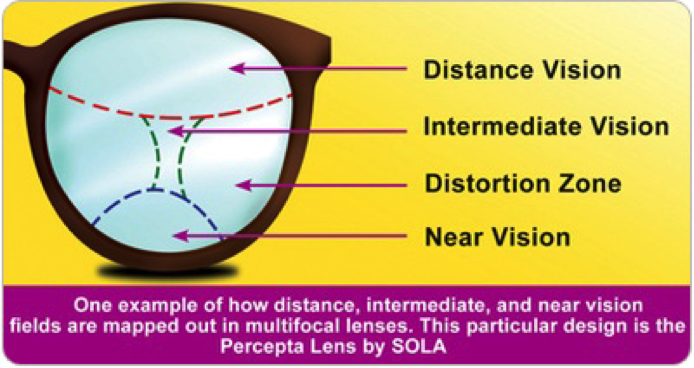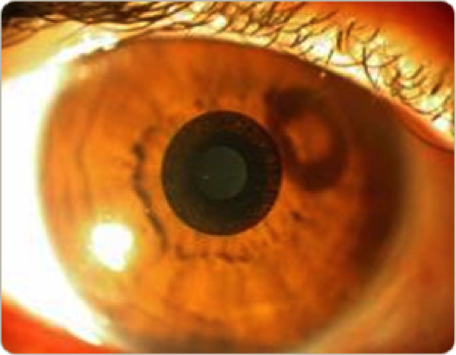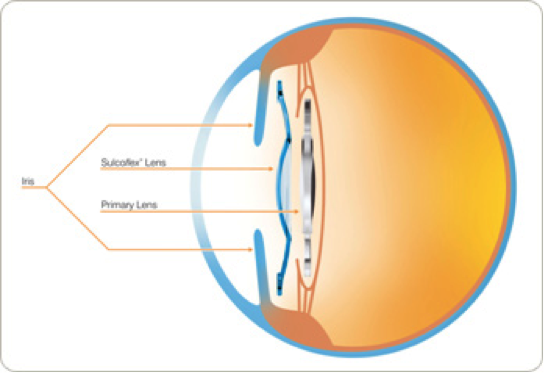Monovision addresses the problem of Presbyopia that most people start to experience at the age of 40-45 when they begin to need reading glasses or bifocals for close vision. With monovision, one eye is corrected for far vision and the other is corrected for near vision. With this, the eye corrected for near tasks will not see objects as clearly when farther away. Usually but not always, monovision works best when the dominant eye is focused for distance vision and the non-dominant eye is focused for near to intermediate vision. The ‘dominant’ eye is the eye our brain tends to favour for ‘sighting’.
One way of dealing with Presbyopia is to use LASIK to produce monovision. However, one should be careful of this technique of monovision as not everyone can get used to it as there is a loss of binocular vision. We would recommend patients to try out monovision with contact lenses to be sure they can adapt to it. This ‘trial’ period is usually for one to two weeks.

Multifocal Intraocular Lens (IOL) have different ring zones to allow the patient to simultaneously see near and distant vision. Although these types of implants have been available for years, recent improvements in design have made them much more popular today.
There are many artificial lenses available including bifocal, multifocal, trifocal and extended range lens implants. Special rings on the implant are designed to offer sharp points of focus and this unique technological innovation provides one with quality vision throughout the entire visual spectrum from near, intermediate & distant vision – with increased independence from glasses.
The Multifocal IOL is suitable for patients who:
- Have cataracts
- Like reading or doing a lot of close work without glasses
- Like independence for distance vision
- Are not fussy about possible side-effects of glare and halos especially at nightv
The Multifocal IOL is not suitable for patients who:
- Have no cataracts (controversial)
- Drive at night for a living
- Work at the computers daily
- Are fussy about night vision side-effects
- Have high astigmatism
Multifocal lens implants are excellent for selected patients with cataracts and can help achieve total spectacle independence and may be the best treatment option for presbyopia and cataracts today.
A multifocal contact lens possesses several zones of differing power to assist the eye gradually as it changes focus on different objects at different distances. Therefore these lenses are designed to function well for seeing objects at a near, intermediate or far distance. Wearers of multifocal contact lenses are expected to need time to adjust to sorting out the different powers and to adjust to the lenses.

What’s available in Singapore?
For soft contact lens, only monthly disposable multifocal lenses are available. They are Bausch & Lomb Soflens Multifocal and CooperVision Proclear Multifocal. For rigid gas permeable presbyopic contact lens, both bifocal and multifocal types are available. The common ones are Renovation Multifocal, Boston Multivision and Menifocal Z lenses.

There are many methods to correct Presbyopia. The vast majority of presbyopes wear some types of spectacles. There are monofocal (reading glasses for near vision only), bifocal (for distance and near vision, separated by a visible horizontal line) and multifocal progressive spectacles (for distance, intermediate and near vision without a visible horizontal line).
Multifocal spectacles are also known as progressive addition lenses (PALs) that allows one to focus on objects through different prescriptions for different distances through the same lens. One segment is for distant, the middle part for intermediate vision and the lower portion for near vision. To learn more about our services, contact us now LINK TO CONTACT FORM
The new small wound pocket insertion KAMRA™ Inlay procedure is a safe and effective procedure to help restore everyday vision while maintaining distance vision. The previous KAMRA™ Inlay procedure was performed by inserting the KAMRA™ Inlay through a large LASIK corneal flap.
The KAMRA™ Inlay is a mini-ring (3.8mm diameter and about 5 microns thin) with an opening in the centre, the pin-hole effect of the KAMRA™ Inlay (implanted in the non-dominant eye) uses the same principle as the camera lens to reduce the blur when viewing near objects, and to focus light rays to increase range of vision.


KAMRA Inlay implanted in the non-dominant eye
The KAMRA™ Inlay is inserted into the cornea of the eye. The corneal pocket, into which the micro-lens is placed, is created by a femto-second laser.
FAQs
What can I expect during the surgery?
First, numbing drops will ensure your absolute comfort duringthe 15 to 20 minute procedure. Second, your eye surgeon will create a microscopic opening on the surface of your cornea and implant the inlay.
Will my eye look different?
The inlay is very discreet. It is significantly smaller than a contactlens and lighter than a grain of salt. Even in blue eyes, it is almost impossible for you or other people to detect.
How long until I notice an improvement?
Your recovery time will vary from a few days to a few weeks or even months. The time it takes to restore everyday near vision depends onyour individual healing time.
When can I resume normal activities?
Most patients resume normal activities and return to workwithin 24 hours after the surgery.
Will I still need my reading glasses?
The goal of the inlay is to reduce your dependency on reading glasses. You may still need readers if you are working indim light, performing a near task for a prolonged period of time or reading tiny print.
Is it normal to notice dimness?
Yes, the inlay blocks a small amount of light from entering the eye, soan image in the KAMRA™eye may appear duller or darker compared to the non-implant eye. Avoiding closing one eye at a time to “see” the difference will make the “dimness” less noticeable until it resolves.
Sulcoflex® Pseudophakic Supplementary IOLs
A multifocal lens that slips over your existing lens implant. This works almost like a clip on or a piggy-back lens.
Following cataract surgery with implantation of an IOL, there is often a high patient demand for near-perfect visual outcomes and an exact refractive result. Unlike with conventional piggy-back IOL implantations, the unique design of Rayner Sulcoflex® Pseudophakic Supplementary IOLs ensures that the potential for contact between the two implants is minimised. This reduces the likelihood of induced refractive error and optical aberrations due to optic surface distortion at the area of contact between the IOLs.
Sulcoflex® Multifocal
Sulcoflex® Multifocal IOLs are indicated for the correction of pseudophakic presbyopia, thereby significantly reducing the need for additional near correction by the use of spectacles or contact lenses. With its carefully calculated combination of refractive power and aspheric design, the Sulcoflex® Multifocal IOLs are associated with excellent visual outcomes, with a remarkably low incidence of halos and glare and, compared with conventional diffractive multifocal IOLs, significantly less loss of contrast sensitivity.
How does it work?

Rayner Sulcoflex Pseudophakic Supplementary IOLs are designed to be implanted in the ciliary sulcus (as illustrated below) to correct any residual post-operative refractive errors following the primary implantation of a conventional IOL in the capsular bag.
Visit https://rayner.com/en/iol/multifocal/ or contact Eagle Eye Centre for an appointment today.
You are suitable if: You have had previous Cataract surgery and currently have problems with Presbyopia; or if you are unhappy with vision without glasses
EEC is proud to be the first in Asia to offer the ICOLENS™ System! A revolutionary alternative to traditional presbyopia treatment options. Implanting the lens leads to an improvement of near vision, allowing the wearer to carry out everyday tasks largely without reading glasses or contact lenses.
The ICOLENS™ System solution is based on the approach of inserting a microscopically small lens with add power (like a reading glass) into the cornea of the eye. The corneal pocket, into which the micro-lens is placed, is created by a femto-second laser.
Ziemer FEMTO LDV Z6 ICOLENS™ pocket software
FAQs
Are reading glasses still necessary after the ICOLENS™ procedure?
In the vast majority of cases, reading glasses are no longer required in everyday situations. However, for longer period of reading or when reading books with particularly small print or in poor lighting conditions, weak glasses may make reading more comfortable. In rare cases the desired result may not be achievable. In such cases the micro-lens can be easily and safely removed.
How long does the procedure take?
In most cases, the procedure takes less than 10 minutes and is performed in an outpatient setting. Normally, you’ll be scheduled to be at the clinic about 45 to 60 minutes prior to the procedure.
Will I experience pain during the procedure?
No. Local anesthetic drops will be placed in your eye and, if required, a tranquilizer might be administered.
When can I return to normal activities?
ICOLENS™ is an outpatient procedure. Typically, you should be able to return to all of your usual activities after one day. Your ICOLENS™ specialist will be able to advise on any specific short term changes to your daily routine.
Does the effect of ICOLENS™ fade over time?
There are no indications as to loss of efficacy of the micro-lens over time. However, as presbyopia is progressive an exchange with a stronger prescription might sometimes be indicated.

